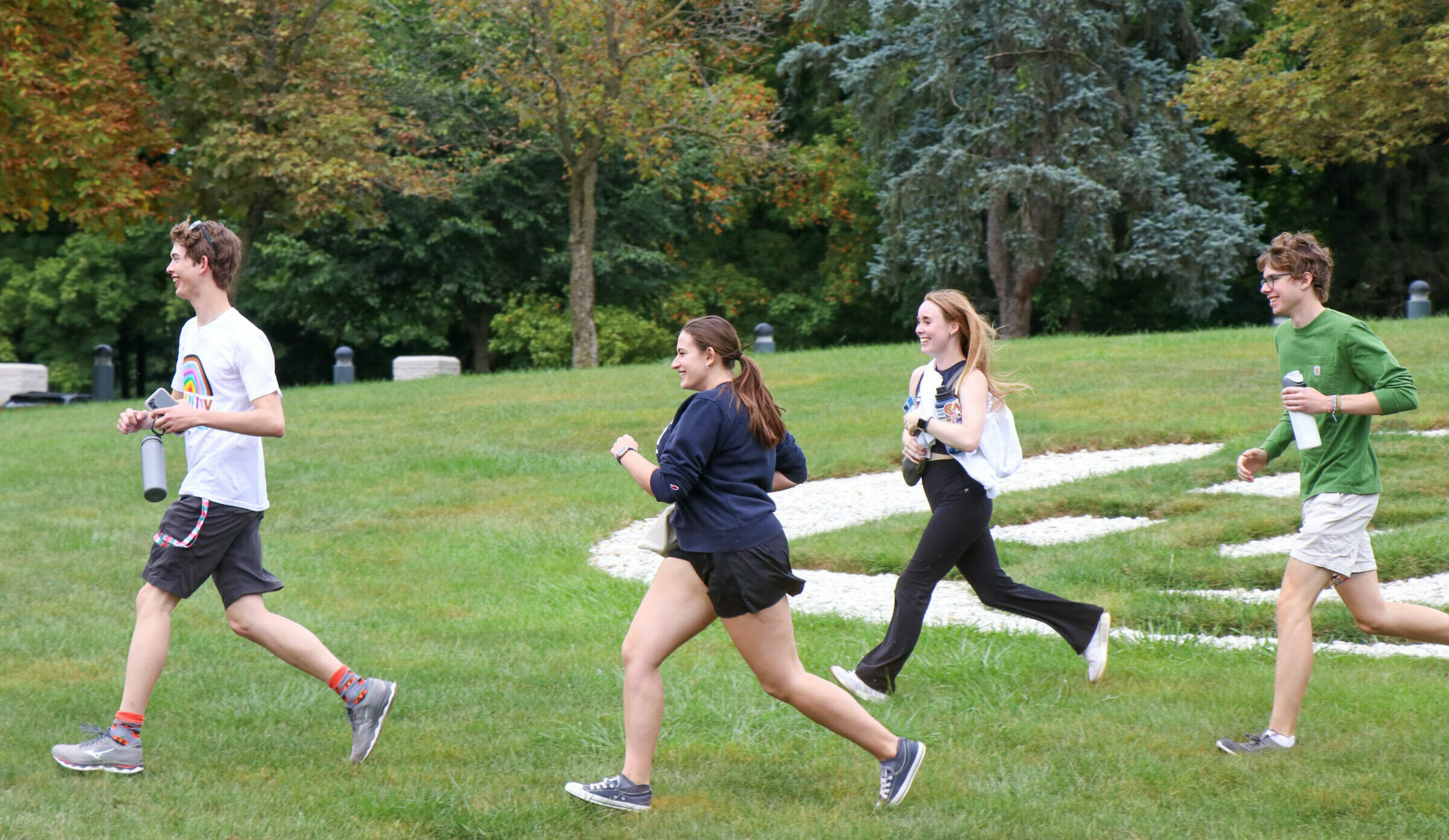Students participate in the annual scavenger hunt. Photo by Grace Hensley.
MAXWELL COLLINS | STAFF REPORTER | mcollins1@butler.edu
Butler’s Department of History, Anthropology and Classics (HAC) gathered behind Holcomb Observatory for their department picnic and fourth annual scavenger hunt last Saturday, Sept. 16. While the picnic has been on-and-off for the past 20 years, four years ago marks when the department added a scavenger hunt orchestrated by anthropology professor Tom Mould, and focused more heavily on building a departmental community.
With plates full of food, students, staff and faculty passed around a pink toy microphone to introduce themselves to new faces and decide on team names. Teams typically had four to five members, which sometimes included people outside the department like friends or the professors’ family. This year, the team line-up included Email Me Back, Wonderpets, Team Mediocre, Team IKEA, New Kids on the Block and Chubby Frogs.
Mould then announced the rules of the scavenger hunt to the teams. This year there were a total of 15 clues, and the answers were spread throughout almost the entire campus. Teams had 45 minutes to rack up as many points as possible by finding answers across campus, each with different point values. Mould explained the final requirement to the eager crowd.
“Running is absolutely allowed, but you have to stay together,” Mould said. “This scavenger hunt is about team building, not team separating.”
With that, the six teams scrambled to read their clues. According to most participants, the beauty of the scavenger hunt is its versatility. There is no pressure to turn the hunt into a competition; some teams walk, and some sprint from clue to clue, some even help each other out.
Ageeth Sluis is a professor of history and affiliate faculty member in the Race, Gender, and Sexuality Studies (RGSS) and International Studies Programs. Sluis is also the director of Global and Historical Studies at Butler. While she was an observer of the scavenger hunt this year, she explained one important skill teams need to be successful.
“Some people have campus knowledge,” Sluis said. “That helps, but I think their chances of winning really depends on their level of passion and enthusiasm.”
The truth is that underneath the exciting fun of a campus-wide scavenger hunt, HAC faculty put on the event to bring a sense of community to the department. As was overheard after scores were announced: “Maybe the real scavenger hunt was the friends we made along the way.”
Professor of classics Christopher Bungard has worked at Butler since 2008. Bungard agreed that the department picnic and scavenger hunt showcase a sense of community in Butler’s HAC department.
“You come to Butler for the community,” Bungard said. “That’s why you didn’t go to a bigger state school that was cheaper to go to, right? So this is one way to kind of get yourself more deeply enmeshed in an amazing community of people.”
As the time remaining slowly drained, those not participating in the scavenger hunt gathered around Mould’s laptop where a spreadsheet was open, tallying each team’s score. With each leaderboard change Mould announced, the rest of onlookers cheered or grit their teeth.
“Following the scores is like the derby!” Sluis said.
Each year, the scavenger hunt includes new questions, making sure no one student or faculty member has an advantage. This year, Mould shared three of the scavenger hunt clues with The Butler Collegian.
-
Blue loves long walks, but only around and through Norris Plaza (he gets anxious walking any farther from it than along its borders). For 4 points, how many steps does he take if he starts at Jordan Hall, takes the longest route possible, but never walks backwards? (1 full paw print = 1 step).
-
In classical architecture a colonnade is a long sequence of columns joined by their entablature, often free-standing or part of a building. One building on campus sports colonnades that would humble Caesar. Using only c, d, i, l, m, v, x, tell me how many arches are formed by the colonnades of this impressive Butler building.
-
The ghost of Lydia haunts two Greek houses on campus. Only one of those houses still stands. Take a photo in front of where the other building once stood.
While the department picnic has been long standing, HAC began putting an emphasis on it when fostering their peer mentoring program.
“We want to make sure that you’re not just coming to our classes to learn,” Mould said. “You’re joining a community of people who care about you as an entire person, and that involves meals together, having fun together, talking ideas together.”
HAC’s peer mentoring program is an opt-in opportunity for first-year students who might be feeling overwhelmed with their new life at college. To encourage students to engage with mentors, the department looked into adding something fun to the picnic. Since that addition came during COVID-19, they knew it had to be outdoors, and in his personal life, Mould had organized scavenger hunts in the past — and so the pieces fell into place.
This year, many students in attendance were seniors, like Kayla Miller, a history and secondary education double major. This was her fourth and final year participating in the scavenger hunt.
“I actually came [to the picnic] for the first time with my original mentor, and then we kept coming back every year,” Miller said. “This year, I got to bring my mentee, so that was very fun. [The picnic has] been a great way for the department to bond, but also for the students to bond.”
Miller explained that she will miss the HAC department and what it brings to student life on campus.
“I think [the picnic has] been one of the most welcoming aspects of Butler,” Miller said. “Just having people who are here to work on your academics, but also have some laid-back, wholesome fun. That’s just the great thing about being in this department.”



